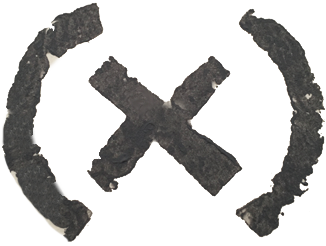Von Trier's Obstructions
by M. Novotny
2017, hair, flubber, lint, glue, glass bell jars, 2" x 5"
The Suzy Daley Collection
#2: From the worst possible situation in the world
#5 : Attributed to one man, made by another
The Provocation
Installation view, San Francisco, CA
The Original Curiosity Cabinet
36"x12"x 42"
Mystical Bezoars and other blockages
organic matter, glass, wood, linguistic hyperbole
“Bezoars were sought because they were believed to have the power of a universal antidote against any poison. It was believed that a drinking glass which contained a bezoar would neutralize any poison poured into it. The word “bezoar” comes from the Persian pād-zahr (پادزهر), which literally means “antidote”.
The Andalusian physician Ibn Zuhr (d. 1161), known in the West as Avenzoar, is thought to have made the earliest description of bezoar stones as medicinal items.[6] Extensive reference to it is also to be found in the Picatrix, which may be earlier.
In 1575, the surgeon Ambroise Paré described an experiment to test the properties of the bezoar stone. At the time, the bezoar stone was deemed to be able to cure the effects of any poison, but Paré believed this was impossible. It happened that a cook at King’s court was caught stealing fine silver cutlery and was sentenced to death by hanging. The cook agreed to be poisoned instead. Ambroise Paré then used the bezoar stone to no great avail, as the cook died in agony seven hours later.[7] Paré had proved that the bezoar stone could not cure all poisons as was commonly believed at the time.
Modern examinations of the properties of bezoars by Gustaf Arrhenius and Andrew A. Benson of the Scripps Institution of Oceanography have shown that they could, when immersed in an arsenic-laced solution, remove the poison. The toxic compounds in arsenic are arsenate and arsenite. Each is acted upon differently, but effectively, by bezoar stones. Arsenate is removed by being exchanged for phosphate in the mineral brushite, a crystalline structure found in the stones. Arsenite is found to bond to sulfur compounds in the protein of degraded hair, which is a key component in bezoars.[8]
A famous case in the common law of England (Chandelor v Lopus, 79 Eng Rep. 3, Cro. Jac. 4, Eng. Ct. Exch. 1603) announced the rule of caveat emptor, “let the buyer beware”, if the goods they purchased are not in fact genuine and effective. The case concerned a purchaser who sued for the return of the purchase price of an allegedly fraudulent bezoar. (How the plaintiff discovered the bezoar did not work is not discussed in the report.)
The Merck Manual of Diagnosis and Therapy notes that consumption of unripened persimmons has been identified as causing epidemics of intestinal bezoars, and that up to 90% of bezoars that occur from eating too much of the fruit require surgery for removal.[9]
A 2013 review of three databases identified 24 publications presenting 46 patients treated with Coca-Cola for phytobezoars. The cola was administered in doses of 500 mL to up to 3000 mL over 24 hours, orally or by gastric lavage. A total of 91.3% of patients had complete resolution after treatment with Coca-Cola: 50% after a single treatment, others requiring the cola plus endoscopic removal. Surgical removal was resorted to in four patients.[10]”
Some inspiration for fake Bezoar creation.





